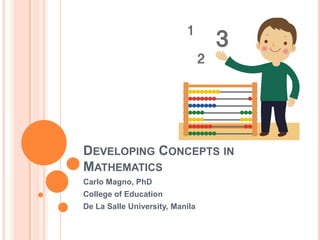
Developing concepts in mathematics
- 1. DEVELOPING CONCEPTS IN MATHEMATICS Carlo Magno, PhD College of Education De La Salle University, Manila
- 2. GET A PARTNER AND ANSWER THE QUESTION (5 MINUTES): What are the important skills that students need to learn in mathematics?
- 3. 13 AREAS OF MATHEMATICS THAT IS IMPORTANT
- 4. 10 BASIC SKILLS IN MATHEMATICS (NCSM)
- 5. WHOLE NUMBER CONCEPTS Skill for K to Year 2 K: Year 1: Year 2: Topic applicable for levels teaching whole number concepts Basic skills before computation skills
- 6. IN A PIECE OF PAPER.. Write the procedure how you can teach the concept of a number to grade 1 students…
- 7. TEACHING WHOLE NUMBER CONCEPTS Payne and Rathmell Triangle Relates the model (representation of the object) with language (name), and symbols in 6 relationships. model --> language language --> model model --> symbol symbol --> model language --> symbol symbol --> language
- 8. Sequencing concept of number STAGE IN LEARNING THE early grouping 2 digit numbers CONCEPT OF WHOLE NUMBERS 3 digit numbers large numbers Numeration process number Numeration recognition principle place value Counting seriation The concept of Separation equivalence number Wholistic comparison and counting structure order Prenumber renaming numerals attribute recognition rounding number sorting and classifying principles patterning counting stages comparison and order
- 9. PRENUMBER SKILLS Attributes Attribute recognition =
- 10. PRENUMBER SKILLS Attributes Matching objects =
- 11. PRENUMBER SKILLS Attributes Continuous-discreet Table Height Window weight Lights Speed chairs distance
- 12. PRENUMBER SKILLS Sorting and classifying Give me a number…. Label the “yes” and the “no” number…
- 13. PRENUMBER SKILLS Patterning 2 2 4 4 6 6 __ __ A B C __ E __
- 14. PRENUMBER SKILLS Comparison and order Comparison (= or =, < or >) Order (2, 4, 6, ___ or skip counting)
- 15. THE CONCEPT OF NUMBER Counting
- 16. THE CONCEPT OF NUMBER Numerals
- 17. THE CONCEPT OF NUMBER Number principle
- 18. THE CONCEPT OF NUMBER Counting stages
- 19. NUMERATION PRINCIPLE Counting
- 20. NUMERATION PRINCIPLE Numerical partitioning and position 384 4 ones 8 tens 3 hundreds Base and values
- 21. NUMERATION PRINCIPLE Wholistic/Quantity aggregate Wholistic
- 22. NUMERATION PRINCIPLE Structure/Multiplicative relationship 111 1x1 10 X 1 10 x 10
- 23. NUMERATION PROCESS Number recognition and place value Reading and writing numbers 1,238 (read or vice versa) 3 ones, 8 hundreds, 2 tens, what is the value?
- 24. NUMERATION PROCESS Seriation – determine the number that is one before or after comparison – working the larger or saller (<, >) Order – putting three or more numbers in sequence
- 25. NUMERATION PROCESS Equivalence and renaming/regrouping 234 = 23 tens and 4 ones 234 = 234 ones 234 = 1 hundred 11 tens and 24 ones 100 110 + 24
- 26. NUMERATION PROCESS Rounding and benchmarking 236 = 240 Show a number line that 236 is very near 240
- 27. SEQUENCING Concept of number – numeral understanding and late operations Early groupings – counting by 1s, counting by 5s, counting by 10s.
- 28. HYPOTHESIS SET A SET B 1 2 5 4 7 6 11 9 13 12 17
- 29. QUESTIONS TO FACILITATE THE CONCEPT ATTAINMENT After observing the numbers, what is the difference of the two sets? What are the characteristics of the first set? How about the second set? Given the characteristics, how would you now define each set of numbers? Give other examples of numbers for the first set, for the second set. How did you arrive with the examples? What guided you in coming up with the additional examples?
- 30. WORKSHOP Create a math game tapping on the whole number concepts of learners Prenumber The concept of Numeration Numeration attribute recognition number principle process sorting and classifying counting Counting number patterning numerals Separation recognition comparison and order number Wholistic place value principles structure seriation counting stages equivalence comparison and Sequencing order concept of number renaming early grouping rounding 2 digit numbers 3 digit numbers large numbers
